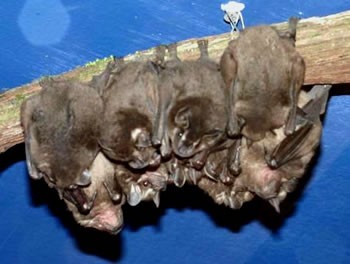― BATS ―
After three years of intense searching, we had finally found our dream home on the lake, and were moving in. As we sat amid the jumbled assortment of suitcases, moving boxes, and scattered furniture, our first sunset was interrupted by a whirring and flickering in the air above us. Looking up, we were horrified to see..Bats! Big, hairy bats. Lots of them. We caught a few when they landed in the drapes, and I made a few successful overhead smashes with the tennis racket. But when we retreated to the small bedroom to hide for the rest for the night, the whirring and squeaking began again when we closed the door. Yep, they were in the bedroom with us. What to do?
Often found in clusters within cracks & narrow spaces.
BAT BIOLOGY
As a specialist in animal control, I knew that the key to controlling critters lies in understanding the enemy. In this case, the bat is the little brown bat. There are 9 other bat species in New York, but the little brown fills the ticket. Its preferred habitat is edges of lakes, ponds, and streams where it hunts mosquitoes, midges, mayflies and other flying bugs to the tune of 500-1,200 per night.

Female little brown bats form maternal colonies beginning in April of 400-1,000 or more bats in warm attics (temperature up to 131F!) where the mother bats give birth to a single batlet in May-June. They nurse batlets for about 3 weeks, after which the little guys can fly. Just before bats fly out to feed on bugs at dusk, they make a horrendous squeaking racket. Mom and kid bats stay in the attics all summer, flying out at dusk to feed and returning before dawn. If the temperature in the attics can drop to about 40F, and humidity can hover around 90 percent (preferred bat hibernating conditions in caves), bats will also hibernate in our attics. Bats can live for 20-30 years, so once they're in your attic, they're there for awhile.
Although people fear getting rabies from bats, there have been only 15 proven deaths from rabid bat bites in the last 40 years. Bats infected with rabies become paralyzed and fall to the ground, so avoiding picking up bats from the ground prevents people from getting rabies.
Usually ,the squeaking at dusk, flights of bats out of attics and the piles of bat guano (droppings) that coats the floors in attics are good clues that you've got bats. Bat droppings are identical to mouse droppings - like black grains of rice, pointed at one end and sparkly in light (wings and other parts in bal droppings reflect light like little mirrors.) Little brown bats are small - 2-3 inches long with a 6-8 inch wing-span - and they can crawl through incredibly small cracks -1/2 inch by 1 1/2 inches, so it's easy for them to get into attics.
BAT CONTROL
One word - exclusion! Mothballs don't work. Leaving lights on in the attic doesn't work. Playing rap or rock music in the attic doesn't work (might drive your neighbors out, though).
You can hire professionals to exclude the bats (after they remove the piles of bat guano). Or you can do it yourself. The most important factor is to complete the exclusion process before or after the bats have young. If you exclude them during the breeding season you might trap the batlets in the house with the mother bats unable to get in. This means that the young bats will starve, die, and stink, and/or the mother bats will find a way to defeat your exclusion to get to their babies.
The first step in exclusion is to locate where the bats are getting in and out of the attic.
Post several people around the house at dusk so they can locate where the bats are coming out to feed. Do this for several nights to be sure all exits are identified.
The next step is to plug up the cracks the bats are using to enter and exit the attic. Hardware cloth can be used to cover large cracks, or the expandable foam that comes in cans may be used to close off the openings. Also sweep up and remove all bat guano from the floor, furniture, and other surfaces. This last step is important, because you determine your success at exclusion by finding no more new bat poop.
You may have to conduct the search for entrances, exclusion, and sweeping for several nights to be sure you've found and closed off all cracks and cubby holes. And that's all there is to it.
Because bats eat so many mosquitoes, and because they will always live with us on the lake, you may want to encourage them to stay in the neighborhood (couldn't keep them away, anyway) by erecting bat houses in the neighborhood. Plans for building bat houses should be available from the county extension service. Attach them to trees or poles in sunny places because the mother bats like warm temperatures for their young.

